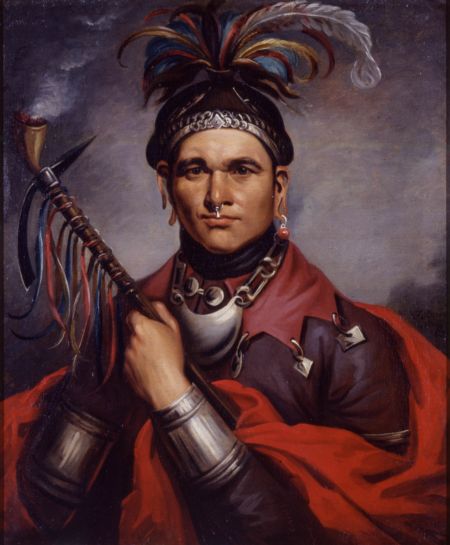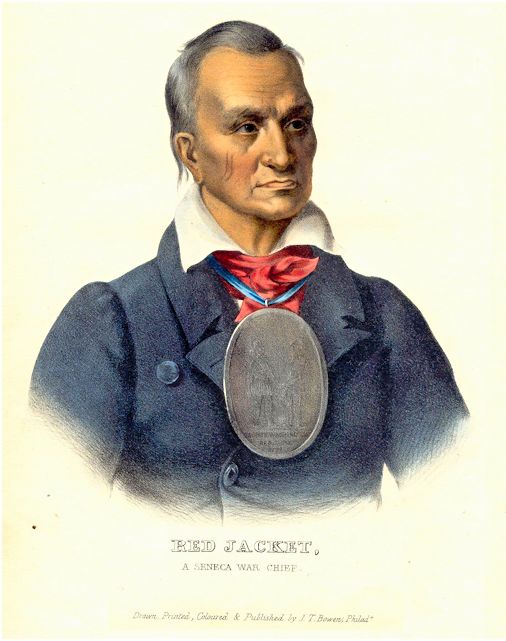Cornplanter(born between 1732 and 1746–February 18, 1836), known in the Seneca language as Gaiänt’wakê (Gyantwachia – ″the planter″) or Kaiiontwa’kon (Kaintwakon – “By What One Plants”), was also known by his white name, John Abeel III. He was a Seneca war chief and diplomat of the Wolf clan.
Famous Seneca
Red Jacket (1758-1830) – The Seneca chief and orator, also known as Sagoyewatha, Red Jacket was born at Canoga (on Cayuga Lake in western New York) as member of the Seneca Wolf clan. He enters historical record around the time of the American Revolution when he is said to have habitually worn a red coat provided him by the British, who employed him as a messenger. Thus the origin of his English name, Red Jacket.
When the War of 1812 broke out, Red Jacket, like many Seneca, became an ally of the United States, fighting bravely at the battles of Fort George (17 Aug. 1813) and Chippawa (5 July 1814). At the latter, heavy casualties suffered by both the New York Seneca and the Iroquois of Upper Canada led both to reconsider their participation in a non-Indian war. Red Jacket played a leading role in the decision of both to withdraw from the Canadian-American conflict.
In his later years Red Jacket described himself at that time as “an aged tree”–“My leaves are fallen, my branches withered, and I am shaken by every breeze.” He died of cholera on the Buffalo Creek Reservation. His remains were later removed to the Forest Lawn cemetery in Buffalo.
Farmer’s Brother (Ho-na-ya-wus) – A Seneca chief, known among his people as Honanyawus, of vulgar meaning, born in 1716, or 1718, or 1732, according to varying authorities; died in 1814. He is often mentioned in connection with Red Jacket, but does not appear to have come into prominence until about 1792. One of his most celebrated speeches was delivered before a council at Genesee River, New York, in 1798. He signed the treaties of Genesee, September 15, 1797, and Buffalo Creek, June 30, 1802. He espoused the cause of the United States in the war of 1812, and although 80 years of age engaged actively in the strife and was present in the action near Ft George, New York, August 17, 1813. He died soon after the battle of Lundy’s Lane and was buried with military honors by the fifth regiment of U. S. infantry. Farmer’s Brother was always an advocate of peace and more than once prevented his tribe from going on the warpath.
Cornplanter (Kaiiontwa’kon, “By What One Plants” and also spelled Kaiiontwa-Ken) Also known as John O’Bail(1740-1836) – Cornplanter was born at Canawagus on the Genesee River in present-day New York State around 1740. His father was an Albany trader named John Abeel or O’Bail, and Cornplanter was known to the English as John O’Bail or Captain O’Bail. His half-brother Handsome Lake was an Iroquois Confederacy chief, as was a nephew who was known as Blacksnake or Governor Blacksnake.
He was living on this “Cornplanter Grant” in June of 1799 when his half brother Handsome Lake, who was living in the same house, arose from a coma and announced he had experienced a vision. The two men continued to live there until 1803 when a dispute with Handsome Lake sent the latter to Coldspring on the Allegany Reservation, where he embarked on his lifelong mission to revive the ancient ways and values while adapting to the new world of the reservation.
Cornplanter continued to live on his Pennsylvania grant for the rest of his life.Cornplanter died on February 18, 1836, and was buried at the Cornplanter Grant. In 1964 the cemetery where he was buried was moved to higher ground to make way for the reservoir that would be created by construction of the nearby Kinzua Dam.
Destroy Town (Onondakai) Destroy Town was a Seneca chief who signed the treaty of 1826. His name is also given as Gonondagie, and formally as Oshagonondagie.
‘He Destroys the Town,’ written “Straw Town” in the treaty of 1815, Oosaukaunendauki in 1797. He was one of those whose remains were re-interred at Buffalo in 1884. The name was a favorite one, but, as applied to George Washington and some French governors, has a slightly different form.
Handsome Lake (1735-1815) – Handsome Lake (Sganyadai:yo) was born in 1735 at the village of Ganawagrahs, in present-day New York State. He was best known as a religious leader. Born into the Wolf clan, he was later adopted by the Turtle clan. Relatively little is known of his earlier life. In July 1777, he and his half brother Cornplanter attended a Great War council of the Iroquois Confederacy with the British at Oswego. Though the brothers initially argued for Seneca neutrality, they later fought alongside the British forces against the revolutionaries. In 1780 Cornplanter and his followers moved to the Allegheny Valley; for the next decade, he traveled extensively among his people, counseling peace with the thirteen states, and went to Albany and Philadelphia to meet with the new state and federal governments.
Blacksnake (1760-1859) – Also known as Governor Blacksnake (Thaonawyuthe), Blacksnake was a man of rare intellectual and moral power. His home was on the Allegany River.
He was a chief who fought with the British at the Battle of Oriskany during the Revolutionary War in 1777. During the War of 1812, he fought on the side of the United States against the English at the Battle of Fort George.
Ely Parker (1828-1895) – Born into a leading Seneca family and steeped in the history and lore of the Iroquois Confederacy, Ely Samuel Parker was also educated in the white world in which he finally chose to live. His father, William Parker, a Tonawanda Seneca chief, fought for the States in the war of 1812 against the British. His mother was a granddaughter of “Sos-he-o-wa,” the successor of Handsome Lake. Five sons and one daughter were born to them. At the outbreak of the Civil War, Ely tried to enlist as an engineer, but was told by Secretary of War, William H. Seward that it was a “white man’s war.” However later, he was given a commission in the Union Army and was discharged a Brigadier General. He was an aide to General Ulysses S Grant, and it was Ely Parker in 1865 who wrote the terms of surrender Grant offered General Robert E. Lee at Appomattox Courthouse. When Grant became president, he appointed Parker Commissioner of Indian Affairs, making him the first Indian to hold that office. He died on August 31, 1895 and on January 20, 1897 his remains were buried in Buffalo’s Forest Lawn Cemetery in the Red Jacket plot.
Half King – (Scruniyatha, Seruniyattha, Tanacharison, Tannghrishon, etc.). A Seneca chief; born about 1700; died at the house of John Harris, at the site of Harrisburg, Pennyslvania, October 1, 1754. He appears to have first come into notice about 1748, at which time he lived at or in the vicinity of Logstown, Pennyslvania. According to some statements his residence was in this village, but according to others it was on Little Beaver Creek, about 15 miles distant.
It was to Half King that most of the official visitors to the Indians of the Ohio region, including Weiser, Gist, Croghan, and Washington, applied for information, advice, and assistance, Logstown being their stopping place for this purpose. He accompanied Washington both on his journey of 1753 and on his expedition of 1754. Half King claimed that he killed Jumonville, the French officer, during the skirmish at Great Meadows, Pennyslvania, May 28, 1754, in revenge of the French, who, he declared, had killed, boiled, and eaten his father; and it was he who had advised Ensign Ward, when summoned by Contracoeur, the French officer, to surrender Ft. Necessity, at the site of Pittsburg, Pennyslvania, to reply that his rank did not invest him with power to do so, thus obtaining delay.
Half King was a prominent figure on the Indian side in the treaty with the Virginia commissioners in 1752, and for this and other services was decorated by Gov. Dinwiddie and given the honorary name “Dinwiddie,” which, it is said, he adopted with pride. On the advice of Croghan, he with other Indians removed to Aughquick (Oquaga) Creek, Pennyslvania, in 1754. Half King has been confused with the Huron Half King of Sandusky, Ohio, known also as Pomoacan, also with Schoroyady (Scarouady, etc.), the Oneida Half King, and with Monakatuatha (Monacatootha, etc.).
Young King –
George Abrams –
Chief John Big Tree –
Guyasuta –
Traynor Ora Halftown –
George Heron –
Mary Jemison –
Little Beard –
Catherine Montour –
Sayenqueraghta –
Tyler Christopher –
Alice Lee Jemison – Journalist and activist
Arthur C. Parker – Anthropologist and author
Sanford Plummer – Artist and author
Seneca Tribes:
Seneca Nation of Indians (F)
Seneca-Cayuga Tribe of Oklahoma (F)
Tonawanda Band of Seneca (F)
Dispute exists about where in New York Red Jacket was born. It could have been at Old Seneca Castle near Geneva, NY, near Cayuga Lake, or even Keuke Lake. His family did spend much time there when he was a boy, and his mother was buried there. So the Keuke Lake location is the most probable.
How Red Jacket Got His Name
22 ViewsThe name Red Jacket, so familiar to the whites, was acquired during the war of the Revolution. He was distinguished at this time as well as afterward, for his fleetness on foot, his intelligence and activity. Having attracted the attention of a British officer by the vivacity of his manners, and the speedy execution of those errands with which he was entrusted, he received either in token of admiration, or for services rendered, or both, a beautifully ornamented jacket of a scarlet color.

